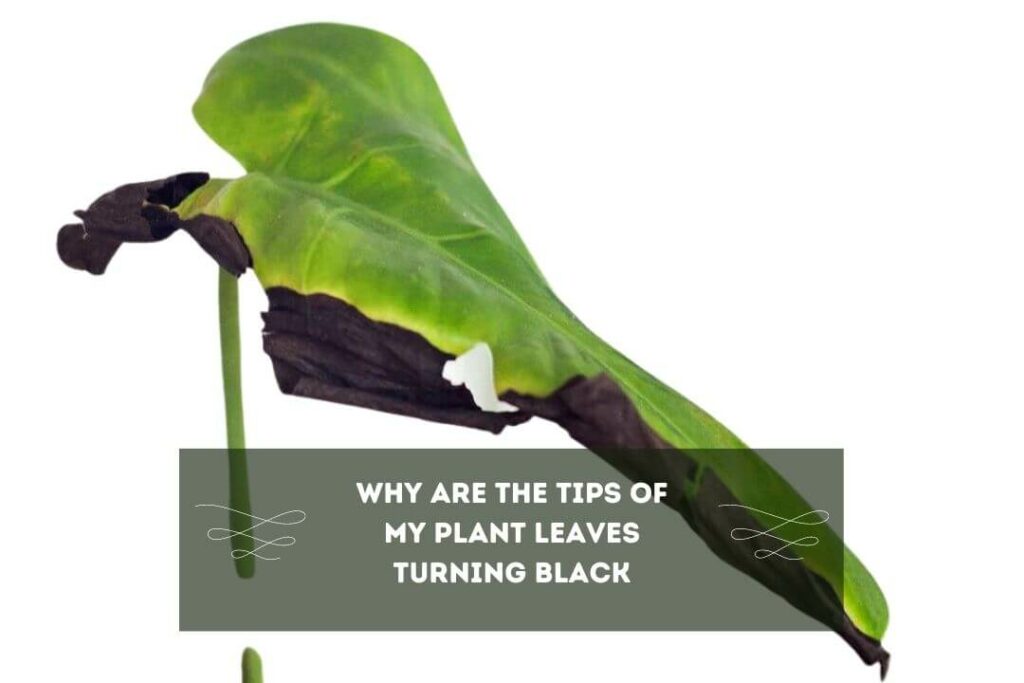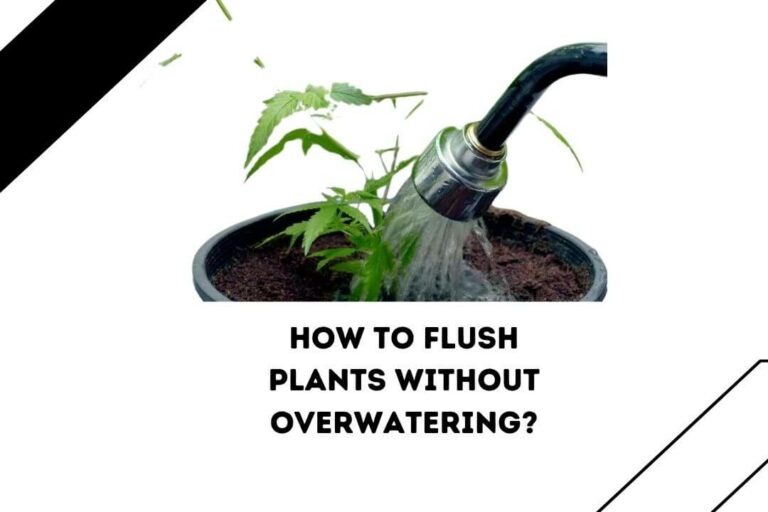If you are wondering, ‘why are the tips of my plant leaves turning black,’ you Are not alone. There can be many factors affecting your plant growth & coloration. In this article, I will help you learn ‘what causes black tips on plant leaves.’
I can understand that plant leaf tips turning black can be very concerning, especially when you have put in so much hard work, time, and effort. Therefore, don’t be so worried or overwhelmed because you can do a few things to address and fix this issue. So, please read this article thoroughly to get your plant back to its normal state of leaf coloration.
Why Are The Tips Of My Plant Leaves Turning Black

Overwatering & Underwatering
If you’re starting with growing plants, you can make mistakes when watering them. Overwatering and underwatering are two of the most common mistakes people make when caring for plants.
Overwatering occurs when you give your plant more water than it needs. If you continue Overwatering, it will lead to root rot, which can ultimately kill the plant. According to the University of California Cooperative Extension, overwatering also leads to nutrient deficiencies as the excess water often washes away essential nutrients.
Some of the most common symptoms of overwatering that you’re likely to notice include yellowing leaves, wilting, and even mold or algae growth on the soil. You may also see a foul odor coming from the ground or roots. If you suspect overwatering is the cult, you must act quickly to save your plant.
Firstly, I advise you to remove it from its pot and gently shake off excess soil. Then, examine the roots to see if there is any sign of rot or damage. I’ll advise you to trim any damaged roots and replant the plant in fresh, well-draining soil but not waterlogged. if your plant is waterlogged, read How to Fix Waterlogged Potted Plants.
After that, water your plant sparingly. It would be best to wait for the soil to dry out slightly between waterings. As per TheSpruce, you can also use a fan to increase air circulation around your plant to help dry out the soil more quickly.
In addition to overwatering, underwatering can also harm your plants. Underwatering occurs when you don’t give your plants enough water it needs, which can lead to wilting, dryness, and, ultimately, death.
According to the Trifecta Natural, symptoms of underwatering can include curling or dry leaves, slow growth, and brown tips or edges on leaves. If this is the case, you should only water when the maximum age of the soil feels dry.
You must make sure to soak the ground all the way through. You can also mist the leaves to increase humidity levels. It’s essential to monitor your plant closely and ensure the soil doesn’t dry out completely. Sometimes, you must repot your plant into the fresh, well-draining ground to give it a fresh start.
Nutrient deficiencies
Another common cause of the tips of plant leaves turning black is nutrient deficiencies. It’s essential to understand what nutrients your plants need to thrive and how to identify the symptoms of nutrient deficiencies so you can take appropriate action.
You’ll find several common nutrient deficiencies that can cause black tips on plant leaves. One of the most common is a lack of calcium. According to the Pennsylvania State University, calcium deficiency can cause the tips and edges of leaves to turn brown or black. This is especially common in tomatoes and other fruiting plants.
Another common nutrient deficiency that can cause black tips is a lack of magnesium. Note that magnesium deficiency can cause the edges of leaves to turn brown or black, and the veins may appear yellow or red.
If you’re looking to cure nutrient deficiencies, you must first identify which nutrients your plants lack. You can do this by getting your soil tested. Alternatively, this can also be done using a nutrient deficiency guide to match the symptoms you see with the appropriate nutrient.
Once you’ve identified the problem, you must take the proper steps to correct it. One of the easiest ways to fix nutrient deficiencies is to apply a fertilizer that contains the missing nutrients.
As you know, calcium nitrate can help correct plant calcium deficiencies. So, You can apply Epsom salt (magnesium sulfate) to the soil for magnesium deficiencies.
You must provide your plants with regular fertilization and ensure they have access to the nutrients they need in the soil. You can also use organic amendments like compost, honey as a natural sweetner and aged manure to improve soil fertility.
Related Article: Using Honey vs Molasses: for plants.
If you don’t know how to identify nutrient deficiencies, look for specific signs on the leaves and other plant parts. For example, calcium deficiency usually causes black tips on leaves, while magnesium deficiency can cause yellowing between the veins.
However, you might also notice some symptoms overlapping. So it’s best to use a nutrient deficiency guide to confirm your diagnosis.
Temperature stress
Another common cause of black tips on plant leaves is temperature stress, which occurs when your plants are exposed to temperatures that are too hot or too cold for optimal growth.
If left unattended, this stress negatively impacts your plant’s growth & development, ultimately affecting its ability to produce fruits or seeds. This is why paying attention to your plants’ temperature needs is essential.
All plants have different requirements in terms of climate, humidity, light, temperature, soil type, water, and nutrients. Depending upon the plant type, you will likely notice a few sizes of temperature stress like wilting, yellowing, or browning of leaves, stunted growth, and reduced fruit or seed production. In extreme cases, your plants may die due to stress.
This is why if you notice temperature-stressed plants, you should first try to identify the cause of the stress. The real problem or culprit could be exposed to high temperatures during the day or low temperatures at night, poor soil quality, or other environmental factors such as lack of water or sunlight.
Once you know what is causing the issue, you should take a systematic approach to address it. If the cause is the high temperature, you can provide shade for plants exposed to high temperatures during the day.
You can do this by using shade cloth or by planting taller plants nearby to provide shade. You should also provide adequate water to plants during periods of high temperatures that will help reduce stress.
If your plants are experiencing low temperatures at night, you must protect them. You can also cover your plant with frost blankets or other protective coverings. Deserve your face that will help keep your plants warmer and prevent frost damage.
Did you know plants can adapt to temperature stress over time through acclimation? Nature blessed us all equally. Surprisingly, plants can adjust their physiological processes to tolerate high or low temperatures better.
For example, plants exposed to high temperatures for a prolonged period may develop thicker leaves or other adaptations that can help them conserve more water and withstand the heat.
Related Articles
Pests and Diseases
There are also some common pests that can indirectly cause black tips, including spider mites, thrips, & whiteflies. These pests suck the sap from the plant’s leaves, causing it to turn yellow or brown and develop black tips.
In addition to problems, diseases like anthracnose & black spot can also cause black tips on leaves. These diseases are caused by fungal infections and can cause black spots or patches on the leaves.
To know if your plants are affected by pests or diseases, look for any signs of damage or discoloration on the leaves. I sometimes use a magnifying glass to look for problems hiding in the leaves.
I also sent a sample of the affected plant to a local plant diagnostic lab for testing. It would be best if you did this a couple of times. It
- If your plants are affected by spider mites, you will notice yellow or brown spots on the leaves along with a web-like substance on the undersides of the leaves.
- If thrips are the culprit, you may see silver or white streaks on your plant’s leaves.
- Lastly, dark and hollow spots or patches on the plant’s leaves indicate anthracnose or black spot.
Once you know what pest is causing black tips, use insecticidal soap or neem oil to kill them and prevent further damage. You can also use yellow sticky traps to catch adult whiteflies and thrips.
To treat diseases like anthracnose or black spot, the Royal Horticultural Society recommends removing the infected leaves and disposing of them in the trash rather than composting them. It’s recommended to keep plants well-ventilated and avoid overhead watering, which can promote the growth of fungal infections.
Environmental Factors
Do you know environmental factors like heat stress, water stress, and nutrient deficiencies can all cause black tips on plant leaves? Heat stress usually happens when you keep your plants exposed to high temperatures for extended periods.
If held for a prolonged period like this, you’ll notice your plant’s leaves becoming scorched and developing black tips. On the other hand, Water stress occurs when you don’t provide adequate water to your plants.
If this continues, your plant’s leaves will wilt and turn brown or black. Lastly, Nutrient deficiencies can also cause black tips on leaves, particularly if your plant is not getting enough nitrogen.
- Heat Stress: If your plants are suffering from heat stress, you will notice brown or black spots on the leaves and wilting or curling of the leaves.
- Water Stress: If your plants suffer from water stress, the leaves will become dry & brittle with brown or black edges.
- Nutrient Deficiency: If your plants suffer from nutrient deficiencies, you may notice yellowing or browning of the leaves and stunted growth.
After learning what is causing a plant’s leaves tips to turn black, it’s essential to take action to fix the problem.
- You can provide shade or move the plants to a more excellent location to address heat stress.
- To address water stress, you can water the plants more frequently or add a layer of mulch around the base of the plant to help retain moisture.
- You can add a fertilizer specifically formulated for the plant variety/types you are growing to address nutrient deficiencies.
FAQ
Why Are Black Tips On Indoor Plant Leaves?
Black tips on indoor plant leaves can be caused by various factors, including overwatering, diseases, extreme light/heat, underwatering, pest infestations, nutrient deficiencies, & environmental stress like heat or dry air. Identifying the specific cause of the black tips is essential to address the problem effectively and prevent further damage to the plant.
Conclusion
I will first recommend you test your soil’s pH level and nutrient content by getting its sample to the nearest lab. You should first determine if your plants suffer from a nutrient deficiency.
In addition, you should also pay attention to the temperature it is kept in and the hours of sunlight it receives. Keeping plants exposed to direct sunlight for an extended period may affect their leaves’ color and cause their tips to turn black.
Overall, I have given all the reasons that could be responsible for plant leaf tips turning black. If you find this article helpful, then consider sharing it.
Your share will help them learn the actual reason behind black tips on plant leaves and what they might be doing wrong and should be doing right. I will advise you to check our other plant care and management guides. See you in the next post, till then, take care and goodbye.

![What to Put Between Stepping Stones? [Plants & Its Alternative]](https://gardenthrone.com/wp-content/uploads/2022/10/what-to-put-between-stepping-stones-768x466.jpg)
![What Do Drift Roses Look Like in Winter? [A Practical Answer]](https://gardenthrone.com/wp-content/uploads/2022/10/what-do-drift-roses-look-like-in-winter-768x431.jpg)
![How to Prevent Squash Bugs from Overwintering? [6 Natural Ways]](https://gardenthrone.com/wp-content/uploads/2022/11/How-to-prevent-squash-bugs-from-overwintering-768x512.jpg)


![What to Do with Potted Plants When It Rains? [A Practical Answer]](https://gardenthrone.com/wp-content/uploads/2022/10/what-to-do-with-potted-plants-when-it-rains-768x412.jpg)
